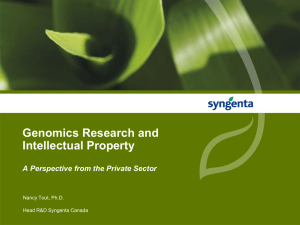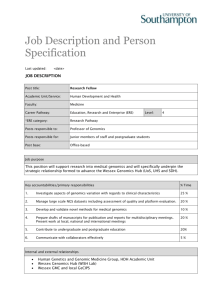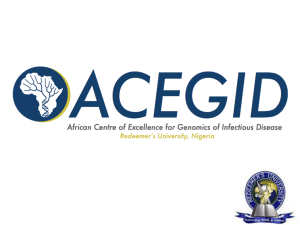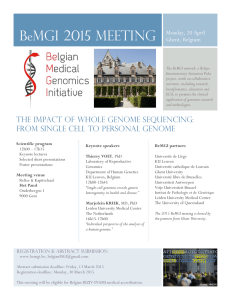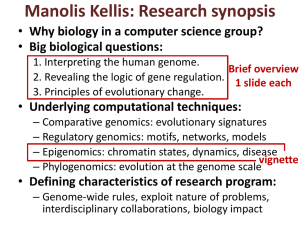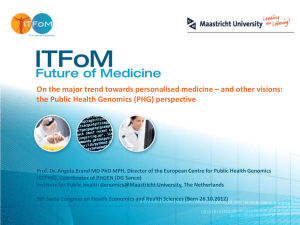Next Generation Sequencing
advertisement
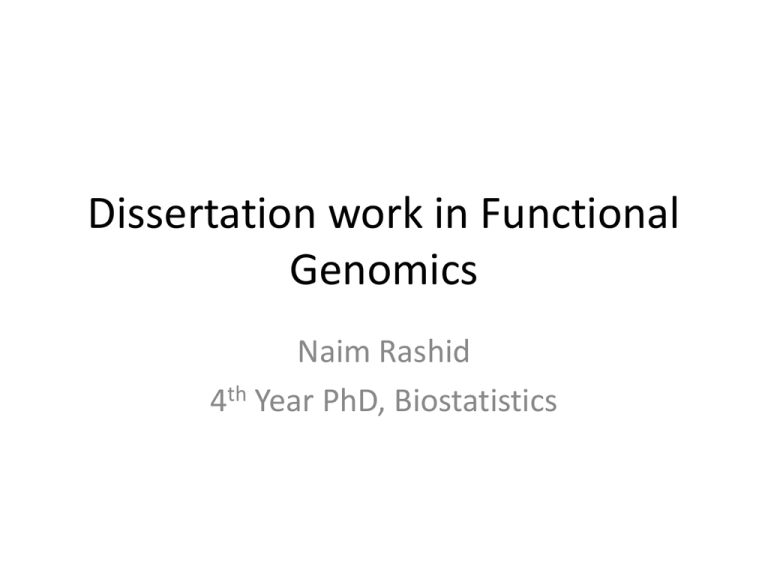
Dissertation work in Functional Genomics Naim Rashid 4th Year PhD, Biostatistics Research in Functional Genomics • How various processes dynamically interact, and in turn, affect gene expression and protein translation • Misregulation/errors provide insight into how diseases develop and how to treat them The Central Dogma of Molecular Biology Research in Functional Genomics DNA Methylation Protein-DNA Interaction Copy Number Abberations Modulation of Open Chromatin Analysis of Gene Expression The Central Dogma of Molecular Biology Research in Functional Genomics DNA Methylation Protein-DNA Interaction Copy Number Abberations Modulation of Open Chromatin Analysis of Gene Expression The Central Dogma of Molecular Biology Measuring this activity genome-wide for a given data type generates an enormous amount of data. Methods for finding interactions between data types and impact on outcomes (gene expression, disease) are also relevant. This is which is where we come in as statisticians Research in Functional Genomics DNA Methylation Protein-DNA Interaction Copy Number Abberations Modulation of Open Chromatin Analysis of Gene Expression The Central Dogma of Molecular Biology The more basic question of how one measures this activity impacts how one develops methods to analyze it. Dependent on what technology is used to measure activity Dissertation Work • First project is dealing with the more basic question of how to best analyze data from a Next Generation Sequencing platform (new) • Microarrays have been the popular platform to assess genomic activity over the last decade • Poised to overtake microarrays in coming years • Build basic analysis framework for this new platform answer more complicated questions later Next Generation Sequencing Microarray Statistical Issues with NGS The local genomic percentage of G and C nucleotides has been shown to have an effect on signal, and this effect has been shown to differ between procedure types (above) and even individuals of the same cell type. Several other biases have been identified Statistical Issues with NGS The way one chooses to represent the raw sequencing data impacts the ability one has to model it. Left is easier to model, but has bad resolution and is subject to boundary effects. Right has excellent resolution, but each point is strongly correlated with adjacent ones, harder to model. Applied Dissertation Project • How to adjust for multiple biases simultaneously, and incorporate this information into selecting enriched regions? • Which biases to use, how to score them and check if relevant? • What is the best type of data representation to select enriched regions? How to overcome the limitations of each • If these questions can be addressed, how do you realistically implement this method for biologists to use? Development of New Method Collaboration ≠ • FAIRE procedure (Lieb lab) is affected more by these biases than others on NGS platforms • Met with lab on a biweekly basis to address these issues. • Had to work closely together to develop the right approach • Communication is key, led to greater relevance of method and extensive testing on real data ZINBA • Collaboration resulted in a method called ZINBA (ZeroInflated Negative Binomial Algorithm) • Mixture of regression models capturing BG (artificial signal) and enriched regions • Regression aspect allows us to estimate effect and relevance of each bias • Model uses window representation to select enriched windows, then calculates overlap representation to get refined boundaries within enriched windows Application to Real Data Our method provides a more appropriate fit to the data Compared to other existing methods, our top calls isolate more relevant regions than others How The Department Made This Work Possible • Genomics training grant allowed me to devote a lot of time to this project • Theory classes – Knowledge of Generalized Linear Model Theory – The Expectation-Maximization Algorithm – Poisson Processes • Learning C led to implementation of C-based translations of R GLM functions, 12x speedup, memory savings • Made Zinba feasible to be used by biologists Future project topics • More theoretical paper addressing issues of variable selection in this mixture model context • Comparing multiple samples, look for differential enrichment across samples. • Develop longitudinal framework to detect changes in enrichment over several time points • Tie together multiple data types to look for patterns related to disease states or gene expression. Questions? • Feel free to email me at naim@unc.edu, or catch me later today
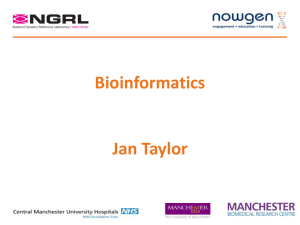
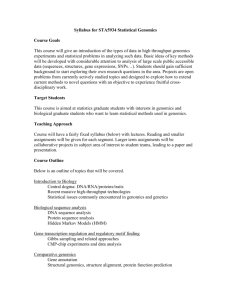
![9_Komlenac - start [kondor.etf.rs]](http://s2.studylib.net/store/data/005352037_1-bdc91b0717c49a75493200bca431c59c-300x300.png)

